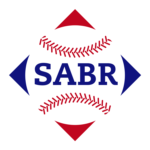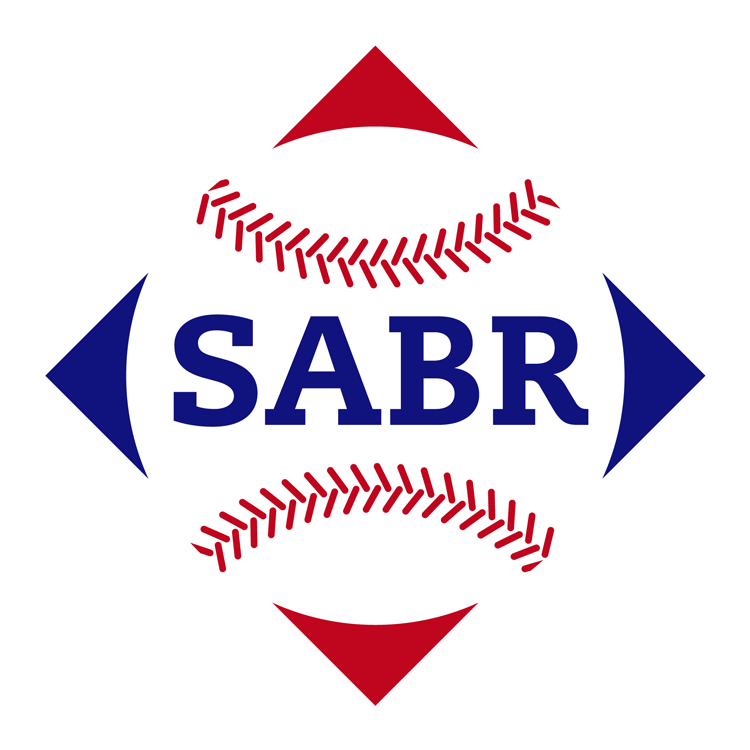In March of 1877 Rutherford B. Hayes was declared the winner of the previous year’s presidential election and was sworn in as the 19th President of the United States. In November Thomas Edison demonstrated his new invention, the phonograph.
In September of that same year, Edward Burgess Peirce, of Lowell, Massachusetts, filed a patent with the United States Patent Office for the “Improvement In Game-Boards”. In the application he claims to “have invented a new and useful Game, which I term ‘Parlor Base-Ball’”.
He continues on, “The nature of my invention consists in the adaptation and application of a table comprising a list a list of the several movements in a field-game of base-ball, and the use of said table in the determining of moves to be made on a miniature base-ball ground, depicted on a board, tablet, or the other suitable surface.”
On May 7, 1878 E. B. Peirce was granted US Patent No. 203,368. Later that year, the Milton Bradley game company, of Springfield, Massachusetts, produced the game for the public.
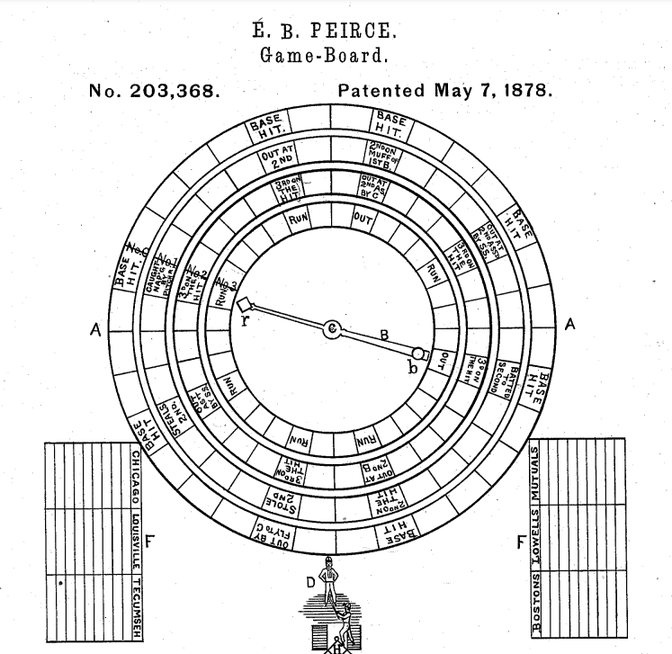
A review of Parlor Base Ball appeared on page six of the November 14, 1878 edition of The American Stationer (A Journal Devoted To the Interests of the Stationery & Fancy Goods Trades).
The new game of Parlor Base Ball, just patented, is an exact counterpart of the national sport, adapted to the quiet of the parlor and fire- side, and in its use, while enjoying a most fascinating pastime, ladies and gentlemen become expert in scoring the game, thereby materially increasing the interest in the field game. Each game is provided with a complete set of checkers, and also furnishes an elegant chess board, with polished walnut frame and beautiful marquetry design in inlaid woods. The rules are very simple, and yet the game has been so carefully prepared by an expert base ball player, that it is said to embody all the exciting combinations of an actual field contest between two professional clubs. When the board is opened, two square tables are presented; in one is the diagram of a ball field, on which are moved checkers representing the players on the batting side. In the other table there is a dial, with a central pivot, on which a pointer is rotated.
To commence the game one player selects the dark checkers, and the other the light, and they determine by lot which goes to the bat first. If the dark, then a dark checker is placed in the batter’s position in the field, a twirl of the pointer determines the fate of the batter, according to the record in the outer and red circle, and the batter is moved accordingly. If he is out the checker is removed to a corner of the table. If a base hit is the record, he is moved to first base, and the move having been made and scored, another checker is placed on the batter’s position and the rotation of the pointer repeated. When there are men at the bases as well as at the bat, the inner or green circle determines the fate of the man at the third base, the yellow circle the second base, and the blue circle the first base. When three dark men have been put out, the light men go to the bat, and the game proceeds as before. The same rules govern the game as in the field, and the score is kept in the same way. If the score is kept complete it appears exactly as though it was the record of a field game. When each side has had nine innings the game is ended, and the party having scored the greatest number of runs wins. The combinations so accurately represent a closely contested field game between professional clubs that it is said to be very fascinating to all who are interested in the great national sport, while ladies may also join, and by this practice very soon learn to correctly score a field game. The actual names of two clubs may be entered on the score card, and the interest is very much increased by so doing, especially if the players are interested in the clubs represented. Milton Bradley & Co., Springfield, Mass, are the manufacturers.
The Publishers’ Weekly of November 16, 1878, contains an advertisement for ‘The New Game of Parlor Base Ball’ for the price of $1.
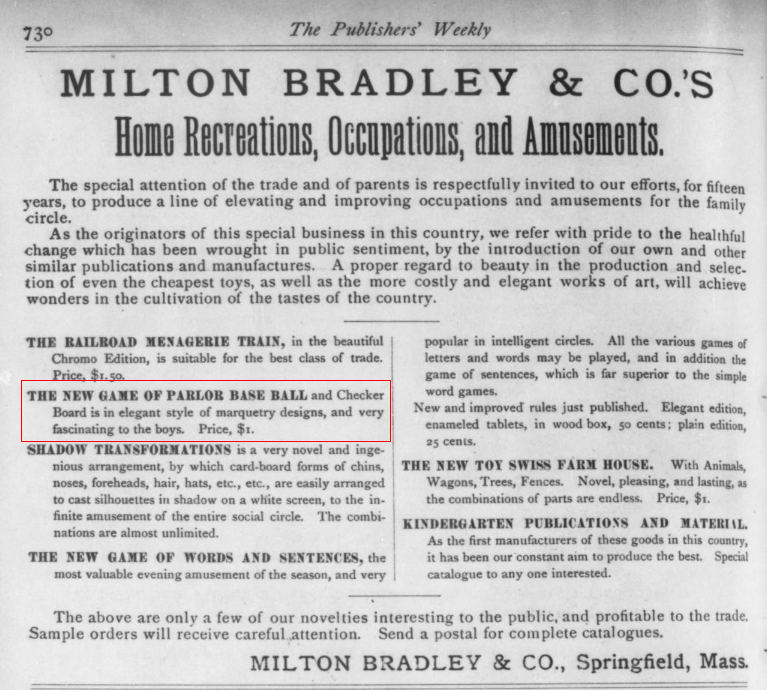
According to FamilySearch.org Edward Burgess Peirce was born on May 27, 1847 in Lowell, Massachusetts. He enlisted in Company F of the Second Massachusetts Heavy Artillery on July 15, 1863 and was discharged on September 3, 1865, having served as a private. Census records show that he was a machinist and city directories indicate that he was also in management and then later real estate. In 1879 Peirce was elected the President of the Common Council for the city of Lowell. He died on June 25, 1919 in Washington, D.C. His obituary states that “he was one of the best informed men on manufacturing and mercantile matters in Lowell.” He is interred beside his wife, Ella A. Folsom, at the Lowell Cemetery.
In 1877 Lowell had a base ball team in the League Alliance. Eight of the players on that team would go on to play in the major leagues, including Sam Wright, brother of George and Harry Wright. I haven’t found any direct connection between Peirce and base ball, but I’m assuming that he witnessed games and spoke about them with his co-workers and friends.
Let’s look at the game that Peirce submitted to the Patent Office and what Milton Bradley produced and sold.
In his patent application there is a drawing of a spinner inside a circular “table”, a drawing of a base ball field, players, and blank forms for team rosters and scoring cards, as well as named clubs for standings. The “table” is divided into 32 equal sections, with four separate circles, one for each each of the different bases. In the patent application the blunt end of the spinner selects the batter’s fate, and then as the bases are populated, the pointy end of the spinner dictates what happens with the base runners.
Peirce included six teams on his patent application for team standings.
- Chicago – member of the 1877 National League
- Louisville – member of the 1877 National League
- Tecumseh – champions of the international Association
- Bostons – champions of the 1877 National League
- Lowells – member of the 1877 League Alliance
- Mutuals – member of the 1876 National League
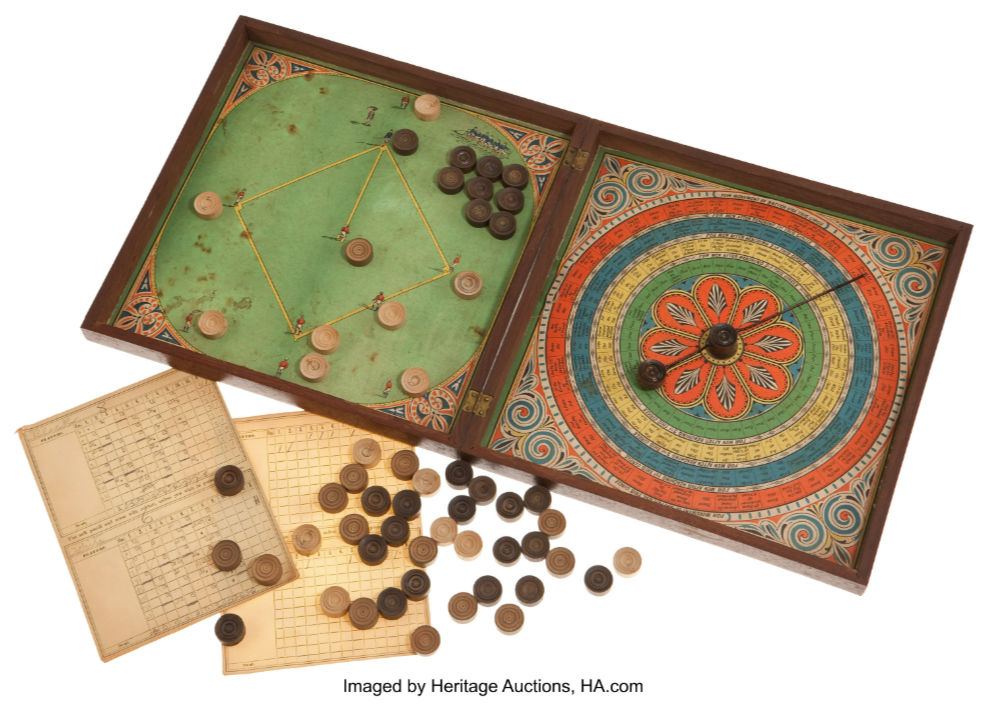
Heritage Auctions had a copy that sold for $5,975.00 in 2013. It is a beautiful piece of art and workmanship. From the auction description the bottom of the game box has a checkerboard. The ball game differs a bit from the patent application. The “table” on the finished game has 48 equal sections. It would appear that the blunt end of the spinner does not come into play.
I have transcribed the “table” into a chart and using either dice (1-100) or an online number generator one can simulate the spinner mechanism and play the game. I changed two of the “table” directives as they weren’t reasonable, IE: the runner on 1st would be instructed to get “3rd on the Hit”, as would the runner on 2nd. Two runners cannot occupy the same base.
I’ve added two additional sections to the finished game, bringing it to 50 sections. They are both blank with the instruction to spin (or roll) again. There is neither a penalty or a bonus for landing on one of these two sections.
Looking at the chances to get on base or advance from a base are rather generous.
The batter will safely reach a base 47.92% of the time. A runner on first will safely advance 79.17% of the time. A runner on second will safely advance 77.08% of the time. A runner at 3rd will make it safely home 77.08% of the time.
In my play testing I’ve found that using a random number generator on my phone and then using that number on the supplied chart to find the results for the batter (and then the base runners in order) works well. Either a printed score sheet or one online works just as well.
To set you in the 1887 / 1878 base ball frame of mind, here are links to various base ball guides of that time:
- 1877 – Constitution and Playing Rules of the National League of Professional Base Ball Clubs
- 1878 – Constitution and Playing Rules of the National League of Professional Base Ball Clubs
- 1878 – Beadle’s Dime Base-Ball Player
- 1878 – Spalding’s Official Base Ball Guide
Things needed for game play.
- Results Table / Chart
- Game Board (simple diagram of base ball field) and tokens to move runners around
- Score Cards (to track runs and outs)
- d100 dice or an online number generator
